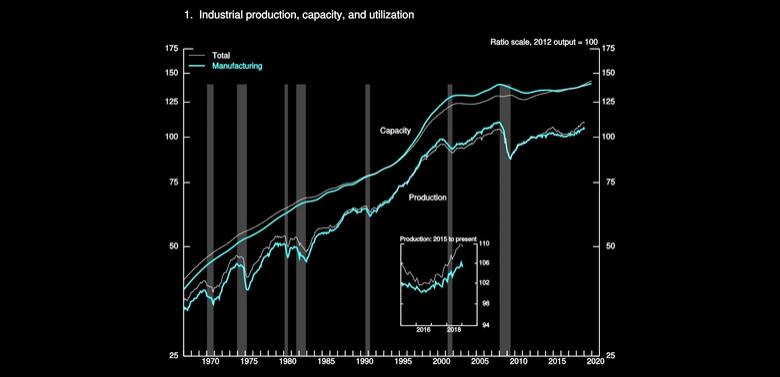
U.S. INDUSTRIAL PRODUCTION DOWN 0.6%

U.S. FRB - Industrial production decreased 0.6 percent in January after rising 0.1 percent in December. In January, manufacturing production fell 0.9 percent, primarily as a result of a large drop in motor vehicle assemblies; factory output excluding motor vehicles and parts decreased 0.2 percent. The indexes for mining and utilities moved up 0.1 percent and 0.4 percent, respectively. At 109.4 percent of its 2012 average, total industrial production was 3.8 percent higher in January than it was a year earlier. Capacity utilization for the industrial sector decreased 0.6 percentage point in January to 78.2 percent, a rate that is 1.6 percentage points below its long-run (1972–2018) average.
Market Groups
The large drop in the output of motor vehicles and parts contributed significantly to sizable decreases posted by consumer durable goods, transit equipment, and durable materials. Results were mixed among other market groups, with many recording little change. Gains of more than 1/2 percent were registered by consumer energy products and by industrial and other equipment, while losses of nearly 1/2 percent or more were registered by information processing equipment, by defense and space equipment, and by construction supplies.
Industry Groups
Manufacturing output decreased 0.9 percent in January to a level that was, nonetheless, 2.9 percent above a year earlier. The output of durable goods moved down 1.7 percent because of a sizable drop for motor vehicles. The index for motor vehicles and parts fell 8.8 percent, as vehicle assemblies fell from 12.3 million units at an annual rate in December (their highest monthly pace since June 2016) to 10.6 million units in January (their lowest reading since May 2018). Most other major durable goods industries also recorded decreases; only fabricated metal products and furniture posted gains. The output of nondurables was unchanged; its components posted mixed results, with only petroleum and coal products recording an increase of more than 1 percent and only apparel and leather recording a decrease of more than 1 percent. The output of other manufacturing (publishing and logging) rose 1/2 percent.
Mining output edged up 0.1 percent in January; the index for mining was 15.3 percent above its level of a year earlier. The output of utilities increased 0.4 percent in January, with natural gas utilities rising 6 percent after falling 19 percent in December.
Capacity utilization for manufacturing declined 0.7 percentage point in January to 75.8 percent, about 2 1/2 percentage points below its long-run average. The utilization rate for mining fell to 94.8 percent but remained well above its long-run average of 87.1 percent. The operating rate for utilities increased to 75.4 percent, a rate that is about 10 percentage points below its long-run average.
-----
Earlier:

2019, February, 8, 11:20:00
U.S. DEFICIT $49.3 BLNU.S. BEA - The U.S. Census Bureau and the U.S. Bureau of Economic Analysis announced that the goods and services deficit was $49.3 billion in November, down $6.4 billion from $55.7 billion in October, revised. |

2019, February, 6, 10:25:00
IMF: GLOBAL DEBTIMF - Global debt has reached an all-time high of $184 trillion in nominal terms, the equivalent of 225 percent of GDP in 2017. On average, the world’s debt now exceeds $86,000 in per capita terms, which is more than 2½ times the average income per-capita. |

2019, February, 4, 09:30:00
U.S. UNEMPLOYMENT UP TO 4%U.S. BLS - Total nonfarm payroll employment increased by 304,000 in January, and the unemployment rate edged up to 4.0 percent, the U.S. Bureau of Labor Statistics reported. Job gains occurred in several industries, including leisure and hospitality, construction, health care, and transportation and warehousing. |

2019, February, 1, 10:55:00
U.S. FEDERAL FUNDS RATE 2.25-2.5%U.S. FRB - Consistent with its statutory mandate, the Committee seeks to foster maximum employment and price stability. In support of these goals, the Committee decided to maintain the target range for the federal funds rate at 2-1/4 to 2-1/2 percent. |

2019, January, 30, 11:05:00
U.S. GDP UP 3.2%U.S. DT - Over the first three quarters of 2018, the U.S. economy grew at an annualized rate of 3.2 percent, the fastest pace for the first three quarters of a year since 2005. Initial data for the fourth quarter indicate the economy continued to perform well, although slowing global growth and the housing sector could present headwinds. Private forecasters in the Blue Chip Economic Indicators monthly survey now estimate that real GDP growth slowed to 2.7 percent in the fourth quarter, and will slow further to 2.2 percent in the first quarter of 2019. |

2019, January, 28, 10:05:00
U.S. ENERGY OUTLOOK 2019EIA - U.S. crude oil production continues to set annual records through the mid-2020s and remains greater than 14.0 million barrels per day (b/d) through 2040. The continued development of tight oil and shale gas resources, particularly those in the East and Southwest regions, supports growth in NGPL production—which reaches 6.0 million b/d by 2030—and dry natural gas production. Dry natural gas production reaches 43.4 trillion cubic feet by 2050. |

2018, December, 24, 12:00:00
U.S. PRIMARY ENERGY PRODUCTION 8.0 QUADRILLION BTUU.S. EIA - U.S. primary energy production totaled 8.0 quadrillion British thermal units (Btu), a 10% increase compared with September 2017 |







